+++ ALPINE ’s radical Alpenglow concept will hit the track for the first time next month, using a hydrogen-fuelled combustion engine that the brand suggests could soon feature in its road cars. Revealed as a static concept at the Paris motor show in 2022, the futuristic Alpenglow will be driven for the first time at Spa-Francorchamps ahead of the 6 Hours race on 11 May. It is said to showcase Alpine’s “design and sustainable innovation ambitions for ultra-sporty road and track cars”, having previously been described as “the starting point for all future Alpine car designs, technologies and breakthroughs”. The Alpenglow’s journey from concept to reality indicates Alpine’s continued commitment to developing alternatives to battery-electric technology in a bid to preserve the emotional and analogue appeal of its sports cars. The firm says the combustion engine will “enhance driving pleasure tenfold” but maintains that it is “a path of exploration” for now, rather than a concrete statement of production intent. The firm has not given any technical details of the powertrain beyond that, though the concept was said to be electrically assisted. Notably, the brand clarified that the Alpenglow prototype will not just serve as a technical demonstrator, but will also preview various design cues that will define the next generation of Alpine’s race and road cars. Its styling will be heavily evolved from the 2022 concept, the brand suggests. A preview image indicates a slightly less outlandish treatment for the front end, with pixel-style headlight designs (likely to become a common feature across the Alpine line-up) and an aero-optimised intake arrangement. The LMP1-style glass canopy remains but is now topped by a prominent air intake for cooling the mid-rear-mounted engine. Alpine earlier suggested the Alpenglow weighed around the same as its A110 sports coupé, in the region of 1.000 – 1.200 kg, with liberal use of carbonfibre helping to offset the added weight of a pair of 700-bar hydrogen storage tanks. Organisers of the Le Mans 24 Hours plan to introduce a new category for hydrogen-powered racers (both fuel cell and combustion) to take part in the race in 2027, having pushed back the mooted 2026 launch date over safety concerns. Toyota (a long-standing proponent of hydrogen-combustion technology for sports and race cars) has already revealed the GR H2 Racing Concept as a preview of its hydrogen-powered Le Mans contender, but Alpine has yet to make a firm commitment to the class. +++
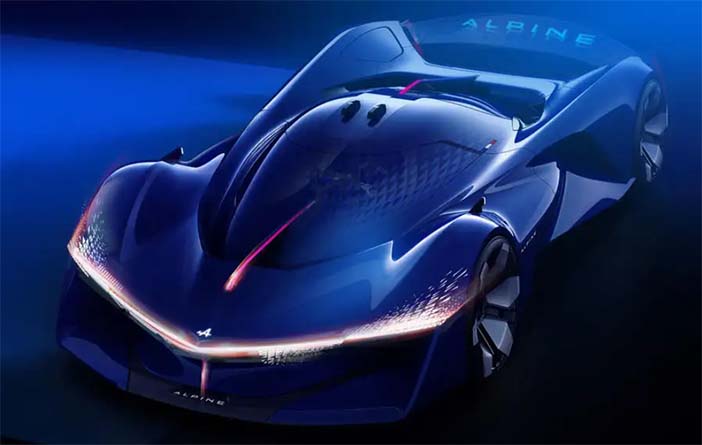
+++ There will “always be demand” for combustion-engined cars, according to ASTON MARTIN executive chairman Lawrence Stroll, who has pledged to keep selling them for as long as he is legally allowed to. Aston Martin recently pushed back its plans to launch its first electric car in 2025 to 2027 and has increased investments in plug-in hybrid technology accordingly. Stroll expects plug-in hybrids to be far more than a ‘bridging’ technology and to remain on sale well into the middle of the 2030s and beyond. Aston customers have told dealers that they want “sounds and smells” and favour ICE technology for their cars, according to Stroll. Aston Martin has developed a bespoke EV architecture and plans to launch 4 electric cars on it (a GT, a SUV, a crossover and a ‘mid-engined’ supercar) but they won’t hit the market before 2027 after a reveal of the first model in late 2026. “We have designed and ready one platform to take 4 different vehicles”, Stroll told. “We have all the products engineered and designed. We planned to launch at the end of 2025 and were ready to do so, but it seems there is a lot more hype in EVs, politically driven or whatever, than consumer demand, particularly at an Aston Martin price point”. He added that demand for electric cars is particularly weak in the luxury segments, as Aston Martins were typically not ‘first’ cars for their customers and used more for leisure. Stroll said Aston “will get there” with electric cars, “but at the previously stated date, definitely not”. In delaying the EVs, Stroll said Aston Martin had “decided to invest very heavily in PHEV technology”. He added: “That would play out for a long while and we will have an extensive offering”. The company’s PHEV technology will be based around V8s, as customers aren’t keen on V6s, said Stroll. The V8 engines will still be sourced from Mercedes-AMG throughout the PHEV era. Stroll said Aston would add hybrid technology to its V12 too. The PHEVs will be based on Aston Martin’s existing architectures and are likely to be introduced into existing model lines. Stroll wouldn’t confirm which Aston would be the first to get plug-in hybrid technology, but the Aston Martin DBX would be an obvious contender, given its position as Aston’s best-selling car. Indeed, when it comes to EVs, Stroll expects SUVs to become fully electric in the luxury segments before sports cars. On PHEVs, Stroll said he “doesn’t see demand slowing at all” for them until at least the mid-2030s, and they were compelling for car makers like Aston for being able to offer electric-only running for urban driving and then huge amounts of performance elsewhere. “They will last a lot longer than people thought even a year ago”, he said. They also allow internal combustion engines to live on, and Stroll said: “For as long as we’re allowed to make ICE cars, we’ll make them. I think there will always be demand, even if it’s small”. Stroll confirmed the Aston Martin Valhalla mid-engined supercar was on track to be revealed and delivered to the first customers by the end of this year. The V8 will be Aston’s first hybrid model and Stroll said the first full year of production was sold out. The Valhalla will be limited to 999 coupé variants initially but Stroll said the platform would be used for derivatives to ensure that Aston always had a presence in the mid-engined segment. The new Aston Martin Vantage will soon be with dealers, joining the Aston Martin DB12, which was launched late last year. The DB12’s launch was delayed by software problems caused by Aston developing its own HMI for the first time ever. However, Stroll said those issues were now behind Aston and would not be repeated on the Vantage and beyond because it’s a plug-and-play system carried over between models. A refresh for the DBX and a replacement for the Aston Martin DBS are both imminent, something that would give Aston dealers “4 new products in 12 months, when we’d done 4 products in 10 years before”, said Stoll. +++
+++ HYUNDAI ’s N division is putting the finishing touches to a hot new version of the Ioniq 6, which will bring Porsche Taycan levels of performance and dynamic agility honed on the racetrack. Hyundai N’s second electric car, following the just-launched Ioniq 5 N, is entering an advanced stage of development shortly after the performance division said it would stop developing petrol cars, following the removal of the i20 N and i30 N hot hatchbacks from Europe. “Going forward in Europe, Hyundai is developing Hyundai N as a pioneer of high-performance EVs”, the brand said recently. “Our customers will benefit from technological developments that will make EVs even more attractive in the future”. The next stage in the performance brand’s transition to an all-EV line-up will be the launch of the Ioniq 6 N, which was previewed by the outlandish RN22e concept in 2022. It was recently spotted testing at the brand’s technical centre in Rüsselsheim, Germany, wearing only light camouflage to reveal the range of styling tweaks it receives over the standard car. As with N’s first EV, the Ioniq 5 N, the visual modifications include wider wheel arches, larger alloys, red brake calipers, deeper side skirts, a larger rear spoiler and a more aggressive-looking rear bumper to suit the car’s performance-oriented billing. Riding on the same E-GMP platform as the hot crossover, the sporting 6 is likely to use an 86 kWh battery to feed a dual-motor, 4-wheeldrive powertrain that produces up to 650 hp and 720 Nm. The Ioniq 5 N touts a BMW M3-beating 0-100 kph time of around 3.5 seconds and 260 kph top speed, but its saloon sibling’s lower profile and sleeker silhouette could allow it to improve on those figures. The Ioniq 6 N is also likely to receive the same chassis tweaks as its sibling, including enhanced brakes, stiffened and lowered suspension, and a gearbox that simulates the behaviour of the 8-speed dual-clutch unit used by N’s combustion cars. It could also receive the 5’s artificial exhaust note, which attempts to capture the spirit of a traditional combustion hot hatch by matching road speed to ‘revs’, and works with the simulated gearbox to emulate the sensation of driving a petrol sports car. +++
+++ JLR , formerly known as Jaguar Land Rover, sold 431.733 cars globally in the financial year ending 31 March 2024; a rise of 22% on the previous 12-month period, as the British brand reduced an order backlog that grew to as high as 200.000 cars. The company blamed the backlog on part shortages (especially chips) coupled with huge demand for the Land Rover Defender and new-generation Range Rover and Range Rover Sport models. Those models made up more than half (57%) of its retail (direct-to-customer) sales in the year to 31 March 2024, with a combined 244.443 cars sold. The Defender (which now has a 3-model line) was the brand’s best-seller with 114.646 sales, remarkably more than doubling (53.1%). +++
+++ LAMBORGHINI has revealed the ultra-limited Huracán STJ: the firm’s final ever car to be fitted with a V10 engine and the jointly most powerful Huracán ever built. Just 10 examples of the STJ (Super Trofeo Jota) will be built. That will effectively see out the Huracán’s production, which started back in 2014, before the model is replaced by a new hybrid sports car later this year. Power comes from the same naturally aspirated 5.2-litre V10 as the Huracán STO, with 640 hp and 550 Nm, managed by a 7-speed dual-clutch transmission. Despite the car receiving no increase in power, Lamborghini says the Huracán STJ can lap the Nardò testcircuit 1 second faster than the standard car thanks to some changes beneath and above the metal. A special aerodynamic package adds two new carbonfibre appendages and adjusts the angle of the Huracán’s rear spoiler by 3 degrees. Lamborghini says downforce has been improved by around 10%. A stronger set of race-derived, four-way adjustable shock absorbers have been fitted, which allow for increased stiffness and improved handling. The STJ also uses Bridgestone Potenza racing tyres. The sports car is available in a choice of two exclusive, eye-catching exterior designs. One features grey Grigio Telesto exterior paint, matched with a black roof and red and white trim. Inside, it gains black Alcantara seats with red stitching. The second design, with bright blue Blu Eliadi paintwork, also gets a black roof with red and white trim details. Both are fitted with a commemorative plaque marked 1-10 to reflect the model’s exclusivity. Lamborghini says the Super Trofeo Jota name represents the “pinnacle” of the Huracán’s performance. The ‘ST’ part of the moniker comes from the brand’s one-make championship, which was formed in 2009, while ‘Jota’ refers to Appendix J of the FIA regulations, which outlines racing specifications. Lamborghini hasn’t detailed the price of the STJ, but I expect it to be significantly more expensive than the SVJ that preceded it. +++
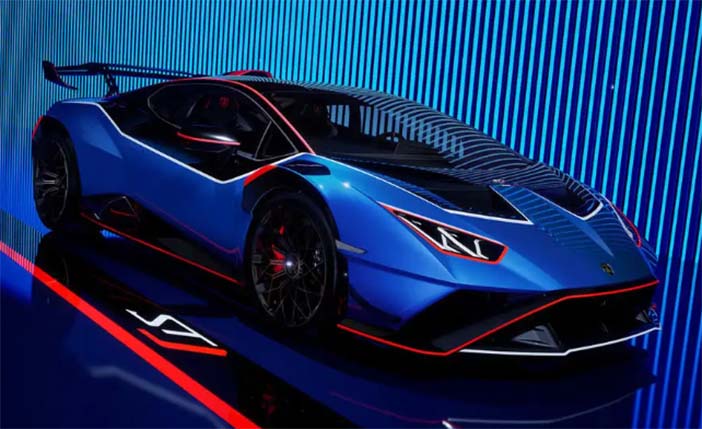
+++ LOTUS delivered fewer than 7.000 cars and posted a net loss of $750 million in 2023, but says it remains on track to achieve its ambitious transformation objectives over the coming years. In its first earnings report since going public in February, the company said it is making “steady progress” towards the aims of its Vision80 business strategy, under which it plans to crack 150.000 annual sales a year by 2028. Last year, Lotus sold 6.970 cars (for revenues of $679 million), which is a record for the brand but still less than 5% of the volumes it plans to be achieving in just 4 years’ time. The company said deliveries increased by 110% in the final quarter of 2023 following the launch of the Eletre, which accounted for 63% of its total yearly volumes, suggesting potentially much higher volumes are possible in 2024. +++
+++ On Thursday April 18th, MAZDA will unveil its all-new, 3-row, CX-80. The second model to be engineered on Mazda’s Large Architecture platform after the CX-60, this is the most spacious car Mazda has on the market in Europe and will become the new flagship for the brand in the region. At almost 5 meters long and with a wheelbase of over 3 meters, the all-new CX-80 is longer and higher than the CX-60. It also has a significantly longer wheelbase. In conjunction with 2 fold-flat third row seats, the CX-80 will be available with a choice of 3 second row configurations, including the choice of 2 separate captain seats combined with a centerconsole. Presales for the all-new Mazda CX-80 will start in May, and the car will be on sale in dealerships from Autumn 2024. +++
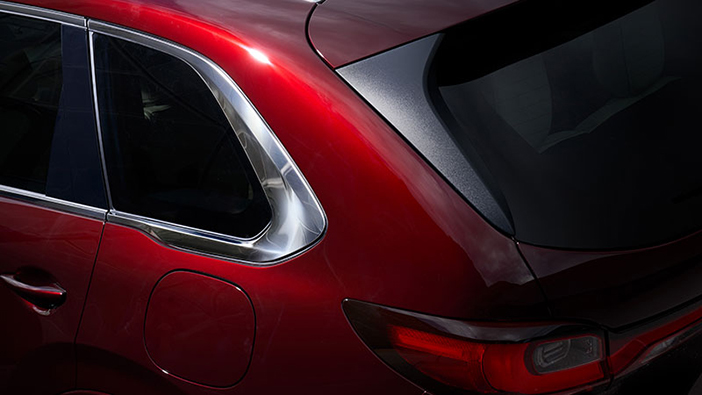
+++ The MORGAN PLUS FOUR has been updated with a fresh look and an optional chassis upgrade aimed at improving its refinement, quality and liveability. The minimalist redesign is intended to return the Plus Four to its traditional proportions, the sports car having grown when it moved to a modern architecture in 2020. Chief among the changes is the introduction of new lights developed in-house by Morgan. Up front, they’re 25 mm larger in diameter, comprising the main headlight beam, indicators and daytime running lights. The rear lights also incorporate the indicators, so the separate lenses have been removed from the car in a bid to declutter its design. There’s a redesigned rear splitter and rear diffuser, painted matte black for concealment and hosting the car’s numberplates. The side and rear-view mirrors have also been replaced with new Morgan-developed units made from aluminium, said to be lighter, stronger and more functional than previously. “Strategic design simplification has reduced visual distraction and celebrates enhanced quality at a component level throughout”, said Morgan design chief Jonathan Wells. Inside, the premium Sennheiser sound system has been revised to provide greater volume, as well as more range for Bluetooth connections. Little has changed under the skin bar the new Dynamic Handling Pack, an optional-extra upgrade developed with suspension specialist Nitron. It adds single-way-adjustable dampers and a rear anti-roll bar. Morgan CEO Massimo Fumarola said: “Whilst other models within our line-up offer greater opportunity for experimentation, the Plus Four requires a more delicate approach. We believe that the new features and detail culminate to create a fitting evolution and an immediate impression of a more refined, usable and quality sports car, yet one that remains playful and fun”. As well as the visual and mechanical changes, Morgan has extended the standard warranty it offers from 30 months to 3 full years. This reflects the “continued development and incremental improvements” to the car since 2020, the company said. +++
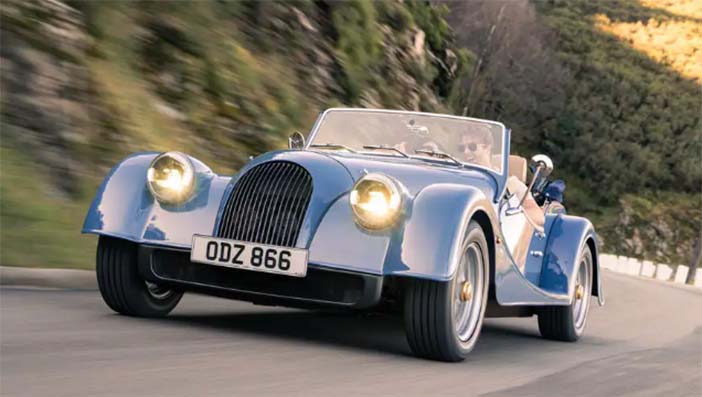
+++ A bold Anglo-Chinese MG Rover revival plan to resurrect the MORRIS MINOR came within an ace of succeeding back in 2005. The scheme was developed in the immediate aftermath of MG Rover’s bankruptcy in April 2005 and led by late former Ford of Europe and Maserati boss Martin Leach’s Magma Holdings consultancy and Shanghai Automotive Industries Corporation (SAIC). It was 1 of 3 competing bids for the remains of MG Rover, which included the hardware to manufacture the Rover 25, 45 and 75 models, as well as the K Series engine. The Minor element of the plan has only now emerged. The car wasn’t detailed in the Magma-SAIC bid, presumably because Leach didn’t want any competitors to get wind of it. Indeed, Steve Young of Indego Consulting, then a key collaborator with Leach, says the Minor revival idea “was something Martin came up with. I wasn’t aware of it”. Young’s specialism was more on business, rather than product planning. Nevertheless, it’s likely that the new Minor would have been central to MG Rover’s revival under Leach. The Magma bid, backed by China’s biggest car maker (which now owns MG Motor, of course), had real credibility, thanks to a combination of factors: Leach’s impressive industry career; the backing of a company already familiar with MG Rover; SAIC having been in serious negotiations to buy the company before it went under; and the support of Unite consultant and former union leader Tony Woodley. Young says: “SAIC would have done all the engineering work with input from the United Kingdom. They had the capability. General Motors, which has a sizeable joint venture with SAIC, had supported them heavily with an engineering center and were very generous in getting them up to speed”. The SAIC plan included new monospace mini, medium and large platforms, and it was onto the smallest of these that the Minor would likely have been built, powered by the K Series engine. The successful bidder stood to gain the rights to not only the MG and Rover names but also Morris and Austin. Reviving the Minor was far from outlandish. Retro cars were heavily in vogue during the early 2000s (think the Volkswagen Beetle, BMW Mini, Fiat 500 and Ford Mustang) and the surprise return of a famous, much-loved model name would have added real impetus to the rebirth of the business. As would adding a Minor Traveller estate, with 4 doors and a split barn-door tailgate, along with a Minor convertible. In the event, it was Nanjing Automobile Corporation of China that won, despite it being a much smaller firm than SAIC and ultimately a far less credible buyer. But it bid higher and without conditions. There was also a UK consortium, this probably the least credible option. Young believes that Nanjing had bid as a means of drawing SAIC’s attention, having previously failed to persuade the larger firm to take it over. He recalls being invited to Longbridge with Leach shortly after it won the bid, and the pair asked what they thought Nanjing should do now. They didn’t get involved, and ultimately the Chinese government pushed the 2 companies to merge in 2007. It made sense: SAIC had acquired the intellectual rights to the Rover 75, 45 and 25 the previous year, when MG Rover was still a going concern. +++
+++ SKODA ’s all-electric line up currently consists of just one car, the Enyaq, but the Czech manufacturer will expand this to 6 models by 2026, including a range-topping 7-seat SUV. The patent images i found of the car show the same design featured in the future model lineup image that Skoda teased us with last year. The picture included the Karoq-sized Skoda Elroq, a family estate and updated versions of the Enyaq and Enyaq Coupe as well as this new flagship SUV. The design of the new 7-seat SUV adheres to Skoda’s new ‘Modern Solid’ design language, which was previewed by the Vision 7S concept. The production version of the Vision 7S will be almost 5 metres long with a traditional SUV bodystyle, making it an all-electric alternative to the Kodiaq. The 7-seat EV will be much more expensive than the Kodiaq, however, with pricing expected to reach €70.000 in the Netherlands. Simply referred to as ‘Space’ by Skoda, the 7-seater shows some interesting quirks in the design images. There are no badges with the traditional Skoda emblem replaced with ‘Skoda’ lettering front and rear. There’s also a wider stance to the car thanks to chunky wheel arches, clean surfacing with sharp lines and more simple bumper design front and rear compared to the Skoda Vision 7S concept. Below the bonnet line there’s a section which resembles an internal-combustion engine car’s grille, but this is expected to be a new variation of the Skoda ‘Tech Deck’. This is a plastic piece of trim that contrasts with the exterior paint and incorporates sensors for driver assistance systems; the sides of this trim section should flow into a set of led headlights. It might not arrive until 2026, but Skoda’s flagship model should be the last all-new car to utilize the basic MEB underpinnings found on the current Enyaq. With the extra wheelbase we expect to see a larger battery fitted than the Enyaq’s latest 82 kWh unit (the Vision 7S featured an 89 kWh battery) which could allow for more range than the Enyaq’s current 545 km maximum. Using older MEB technology could reduce manufacturing costs at Skoda’s Mladá Boleslav factory in comparison to the VW Group’s upcoming SSP architecture, which is also due to launch in 2026. Inside the new car we’ll see a more sedate cabin layout than the wild 6+1 seating arrangement of the Vision 7S, which also featured rear-hinged rear doors and no B-pillar (like a Honda Element). Skoda points out that its ‘Modern Solid’ design language extends to the interior with an focus on making “the user experience as simple and intuitive as possible” thanks to the use of physical controls. +++
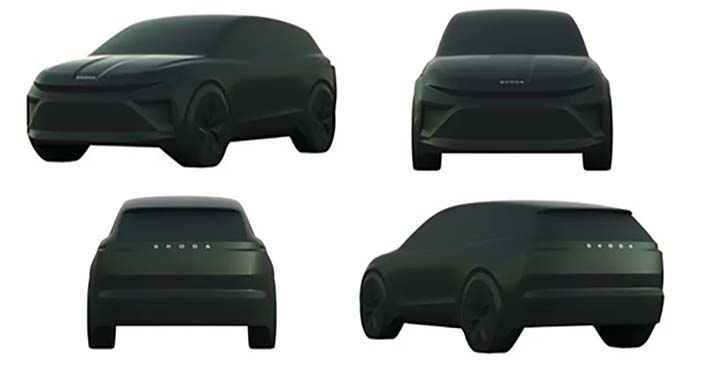
+++ STELLANTIS boss Carlos Tavares has called suggestions that the car giant could end production in Italy or sell off any brands “fake news”, and he said he has rebuffed an effort by a Chinese firm to buy one of its marques. Speaking at the launch of the new Alfa Romeo Milano, Tavares cautioned Italian authorities against offering incentives to encourage Chinese firms to set up battery or car production in the country. Stellantis was formed in 2021 by the merger of Fiat Chrysler with the PSA Group, encompassing 14 brands. But there have been ongoing questions about the future of some of the ex-FCA brands, including Fiat and Alfa Romeo, which feature aging products and poor sales. Tavares admitted that some executives within Stellantis suggested he should “kill” some of those brands and said in 2021 he received an offer from a western competitor to buy Alfa Romeo. +++

